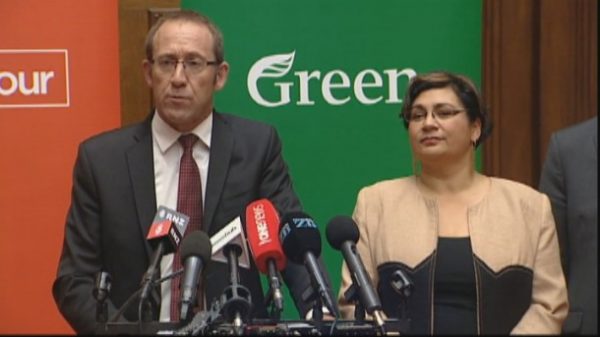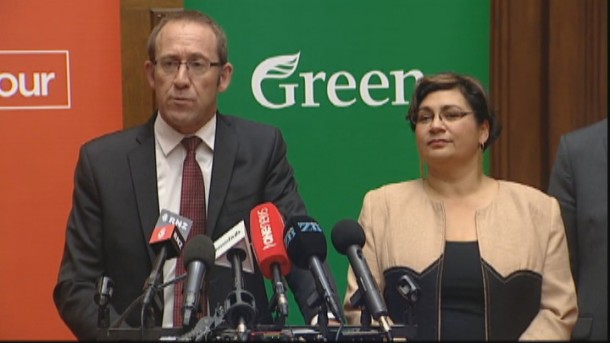
The launch was a clumsy flop, but the strategy behind using MMP to beat the National Party in 2017 is actually not only possible but likely.
The real gain Labour and the Greens want out of this MoU (which is just such an unimaginative name – it should have been called ‘The People’s Revolutionary Grand Alliance’), is the change in perception by the idiot media who still can’t, after 20 years, comprehends how MMP politics works.
The sleepy hobbits of Muddle Nu Zilind don’t understand how close the election actually is. If they start seeing the Labour-Green block reported as a total each month when the polls roll out, they will start seeing National at 40 something and Lab-Green combined also at 40 something.
The real problems for the Opposition are created and projected by the way the mainstream media reports politics and if voters are constantly told Labour is languishing in the low 30s while National are in the high 40s, the perception is National are untouchable.
This change in reporting will have a big impact in reminding voters how close the election really is.
Apart from perception changes however, the real power in using MMP tactically will come if Labour and the Greens can agree to common positions on strategic electorates.
Ōhāriu allows Peter Dunne a seat in Parliament and gives National an ally. Dunno won 13,569 votes in 2014, Virginia Andersen from Labour took 12,859. The Green candidate, Tane Woodley took 2,764. If the Green Candidate stood aside, Labour have a much more likely chance of beating Dunne.
Auckland Central is another electorate. Nikki Kaye won 12,494, Jacinda took 11,894 while Denise Roche got 2,080. If Denise stands aside, Jacinda finally wins Auckland Central back.
Waiariki could be the most fought for electorate. Labour and the Greens would want to reach out to Annette Sykes voters and attempt to wrestle away the electorate from the Maori Party which would take out Flavell AND Marama Fox. That’s 2 less votes for the Government.
If the Greens and Labour can put some ego aside and actually work together in those electorates, and others, then they have a chance to eliminate National Party support parties making it more difficult for National to get to a parliamentary majority.
Much has been made of NZ First disliking the Greens, but that’s misrepresenting the reality. Politics is all about personalities, and Winston despised Russel Norman for grilling him over the donations scandal that plagued NZ First in the last days of the Labour Government. Russel has gone, and so has much of that resentment. The new Green Party Chief of Staff, Deborah Morris, is a former NZ First Youth Minister and she spoke to Winston before she took that job.
The relationships behind the politics is what makes alliances, while the launch was a bit vacant, there is a way this changes a Government in 2017. They need a shared policy platform and an agreement on specific electorates.






“Using MMP to beat the National Party in 2017 is actually not only possible but likely.” Good plan and discussion Last night on 5th estate.
Oh yes , – this is the way!
Nazional used it effectively so the opposition all should negate any tricks the Nazional plotters use this time also.
Time to eject this cancerous Nazional growth from our society.
“Apart from perception changes however, the real power in using MMP tactically will come if Labour and the Greens can agree to common positions on strategic electorates.”
*cough cough* indeed
I have always wondered why this arrangement was not is place many moons ago, obviously these parties did not really understand how MMP works. Labour, Greens and NZF have to work together post Election.
Winston and NZF will probably have the option of going with JK and National but I would say that would be highly unlikely after Dame Jenny Shipley f****d NZF and Winston over after the first MMP Election. Also JK has stated publicly that he would not work with Winston and NZF.
Winston was working quite well with Jim Bolger and National under MMP until Shipley overthrew Bolger, Winston also worked quite constructively with the Helen Clarke Government so we were lead to believe.
100% JR Right on target mate.
I have always wondered why this arrangement was not is place many moons ago, obviously these parties did not really understand how MMP works. Labour, Greens and NZF have to work together post Election.
Winston and NZF will probably have the option of going with JK and National but I would say that would be highly unlikely after Dame Jenny Shipley f****d NZF and Winston over after the first MMP Election. Also JK has stated publicly that he would not work with Winston and NZF.
Winston was working quite well with Jim Bolger and National under MMP until Shipley overthrew Bolger, Winston also worked quite constructively with the Helen Clarke Government so we were lead to believe.
Bomber. Good to see you have warmed to the idea.
Politics is not just about razzamatazz. If that was the case Len Brown would be the most popular politician in the country.
Bomber, I’m glad that you’re taking the long view & laying out the positive aspects of the MOU. Pity Chris Trotter isn’t doing the same. His stance reminds me of the saying, ‘The Left never multiplies, it only divides.’ Chris would rather be in control of the losing side, than lose control of the winning side. Get a grip, Chris – the MOU is the best thing that’s happened to NZ Social Democracy in the last 10 years. Any arrangement which aims to rid NZ of the shitty Key Govt has got to be a good one.
Dean Chris was positive tonight on the brilliant show on The 5th Estate, a must see.
“Ōhāriu allows Peter Dunne a seat in Parliament and gives National an ally. Dunno won 13,569 votes in 2014, Virginia Andersen from Labour took 12,859. The Green candidate, Tane Woodley took 2,764. If the Green Candidate stood aside, Labour have a much more likely chance of beating Dunne. ”
Time for Green voters in Ōhāriu to vote more strategically and give their electorate vote to the Labour candidate. Why not, the Nats stitch up a deal every time with Dunne.
Funny isn’t it that the Nats are hysterical at this MoU, but think their deal-making with Act and Peter Dunne is just fine.
Hypocrites.
1000% PRISS Nazional’s motto is “Do what I say, Not what I do”!!!!!
Great to have Labour and the Greens divide up electorates for local victories. One can hope that Labour will understand that it cuts two ways, the Greens should finally be able to get an elected MP.
A big assumption that every Labour voter will vote Green, and vice versa. It’s well know that many in Labour think the Greens are unpalatable. The only winner is Winston.
He could be out polling Labour come election time, and who knows what he’ll do
Hmmm…interesting it is. It is always amazing that big decisions are generally almost always made by people who either like or dislike each other but that is the truth.
During the second world war for instance , generals on both sides often competed with each other , and where there was personal animosity there was often discord with horrific results for the soldiers and the civilian populace over the short and long term.
Where there was cooperation and a sense of working together with a common objective and putting aside personal beefs… then great advances were often made. And its no different from a united coalition arrangement in politics. Small victory’s encourage even more bold audacious forays and wins.
Soon,… the announcement of several platforms can be made, being careful to hold certain aspects close to their chests. If Key can announce ‘possible ‘ tax cuts, – then the opposition can announce their own counter to that for example.
Focusing on the failures of National in the big four areas- health , education , welfare, wages … the bread and butter issues … will grind National down… along with letting National hang itself by continual glaring failures. Let National do the work for the opposition instead for the soon to be govt.
Discussing electorate strategy should be a given. Under no circumstances should there be any proceeding without close consultation and a constant analyzing of those electorates. They need a game-plan, but flexibility to maneuver as well.
Along with these aspects, a constant monitoring of issues to be found on the right side of public opinion – though not at the cost of integrity. There’s still a way to go before 2017, but with a well conducted campaign there is more than a chance of victory.
Bloody well said Wild Katipo.
Put yourself up as a PR advisory role in the opposition plank please!
Transport is a biggie also, as now we should see Nationals’ wild wanton destruction of our public Kiwirail regional rail asset must now cease.
Kiwi rail’s Chair and COE have recently pleaded like beggars for National to help save regional rail but these begging efforts were greeted with a surly NO but this Regime.
Within all regions there are deep serious community concerns from all quarters over all those regions now facing rail closures that may well cause a shift in National loosing several seats in the next election because of the national severe political interference into Kiwi rail’s attempts to revitalise the regional rail services or even to lease some to Local Councils as HB regional Council are now attempting to do to save the whole Eastland rail services.
Similarly National careless abandonment of all regional funding to save the Northland, East Coast, Tararua, Wairarapa, Taranaki, Waikato, and many south Island regional rail services will cost them several seats in parliament if they continue their wanton destruction of these urgently needed rail services as they cut and slash Kiwi rails budget and “redirect all funding to Auckland passenger rail and Wellington commuter rail now being run both by private European companies and this causes the total continued loss and erosion of urgently needed revenues to help Kiwi rail to survive.
Bet on this being a big election issue going forward now.
Nobody should be getting their hopes up for 2017. Indeed, the wisest course would be to be prepared for collapse:
‘The Structure of Collapse: 2016-2019
Leaders face a no-win dilemma: any change of course will crash the system, but maintaining the current course will also crash the system.
The end-state of unsustainable systems is collapse. Though collapse may appear to be sudden and chaotic, we can discern key structures that guide the processes of collapse.
Though the subject is complex enough to justify an entire shelf of books, these six dynamics are sufficient to illuminate the inevitable collapse of the status quo.
1. Doing more of what has failed spectacularly. The leaders of the status quo inevitably keep doing more of what worked in the past, even when it no longer works……
http://charleshughsmith.blogspot.co.nz/2016/06/the-structure-of-collapse-2016-2019.html
Comments are closed.